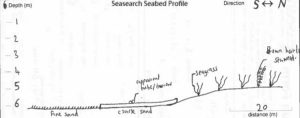By car, take the turning off the Glenariffe Road onto Dalriada Avenue. Follow the road to the end and parking is available in the lay-by above the pier. From here you can access the shore from beneath the slipway. There are three areas to explore from the entry point: (1) rocky gullies to the north of the pier, (2) rocky gullies to the south of the pier (recommended for avoiding anglers) or (3) seagrass bed directly off the pier at ~7 metres depth.
Free car parking available on the lay-by adjacent to the pier. Be careful not to obstruct resident’s access. Nearest toilets/showers at Cushendall Sailing and Boating Club.
Nearest tank filling is Aquaholics, Portstewart/Ballycastle (call in advance: 028 7083 2584)
- Recreational boating out of Cushendall or Dalriada Piers.
- This is a popular site for shore angling, so there is a possibly risk of entanglement in fishing gear.
- Occasionally strong north – south current.
- Don’t go too far around the corner to the north (leading round to Cushendall beach), as there can be a strong counter current here when the tide begins to run.
- If diving to the south of the pier, be aware of the sewage pipe leading out from the caravan park!
There are many rocky gullies to explore on both the north and south sides of the pier. As you move off the rocks and away from the shore, you come to a sandy, gravelly, seabed with patches of seagrass. There are also some parts of small boat wreckage on the seabed near the pier. This is a great site for novice divers and snorkellers.
Various crustacean, sea squirt, nudibranch and starfish (incl. the common starfish Asterias rubens and the spiny starfish Marthasterias glacialis) are found amongst the gullies to the north. These are covered in pink encrusting algae. There is a seagrass Zostera marina bed off Dalriada pier on a sandy seabed. Seagrass is a priority marine habitat, which provides an important nursery ground for many species, including a variety of fish, which can be seen here.
View all species records from this site
A link to the dive site location on the NBN Atlas Northern Ireland website, showing all species records from within a 1km boundary of the site centroid. Any new species records from the site submitted to Seasearch, iRecord, CEDaR Online Recording or iNaturalist will appear here- In an emergency call 999 or 112 and ask for the coastguard.
- Follow VHF radio Channel 16 (156.8 MHz), the international distress frequency.
- Find nearest defibrillator (AED) here






















Leave a Comment
Dived here recently? Then let other divers know about this site from your experience!